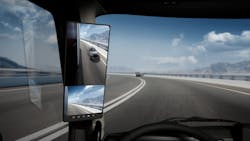Key takeaways:
- Advanced safety features in the Mack Pioneer include airbags and a high-strength steel cab that exceeds safety standards for maximum driver protection.
- The E-Call 911 feature automatically contacts emergency services and activates safety measures during incidents.
- The digital mirror system improves visibility and aerodynamics, while the chassis design redirects crash energy away from the cab.
Mack Trucks recently announced details of the passive and active safety technologies in the Mack Pioneer. The Pioneer introduces a suite of safety features, including front and side curtain airbags, a digital mirror system, and a high-strength steel cab designed to exceed rigorous safety standards.
“The safety features in the Pioneer reflect our deep understanding of drivers’ needs and our commitment to their well-being,” Stephen Roy, president of Mack Trucks, said. “With professional drivers spending an average of 150 hours per month in their trucks, we’ve engineered safety technologies that provide protection before, during, and after any potential incident.”
Emergency response technology
The Pioneer comes standard with driver and passenger frontal airbags, with optional side curtain airbags. These supplemental restraint systems work in conjunction with seat belt systems and cab structures to provide protection in the event of a collision.
The Pioneer also features Mack’s new E-Call 911, an automatic emergency response system similar to those found in modern passenger vehicles, bringing automotive-grade safety technology to the commercial trucking industry. When activated by airbag deployment or a detected rollover event, the system automatically executes a series of coordinated safety measures: Doors unlock to facilitate easy exit during emergencies, interior lights activate to improve visibility for first responders, and the system immediately contacts emergency services with the vehicle’s location.
See also: All-new Mack Anthem targets regional haul
Steel cab with crash protection
The Mack Pioneer features a high-strength steel cab that exceeds federal safety requirements and additional global testing protocols. The cab has been tested against Swedish Impact standards and UN ECE R29 Cab Strength protocols. There were also additional tests conducted, including frontal sled, trailer barrier, and 90-degree rollover scenarios.
“Our cab design prioritizes driver protection under all circumstances,” Jonathan Randall, president of Mack Trucks North America, said. “We’ve subjected the Pioneer to extensive testing beyond what’s federally required, including specialized roof crush, A-pillar, and rear-wall impact scenarios to ensure maximum occupant protection.”
Chassis design for enhanced safety
The Pioneer’s chassis design includes splayed frame rails that direct crash energy away from the cab. The chassis frame is constructed using high-tensile steel that provides strength while maintaining optimal weight distribution for vehicle stability. In the event of a frontal collision, this design allows the engine to break away and drop below the cab rather than being pushed toward the driver.
“The splayed frame design is a crucial safety feature,” Scott Sokach, safety product manager at Mack Trucks, said. “By directing the engine downward in a collision, we prevent it from intruding into the driver’s space, significantly reducing the risk of lower extremity injuries.”
Digital mirror system improves driver visibility
A safety innovation in the Pioneer is the digital mirror system—a first for Mack—which replaces traditional side mirrors with cameras mounted in sleek pods. This system improves driver visibility by eliminating blind spots while also enhancing aerodynamics.
“The digital mirror system represents a major advancement in both safety and efficiency,” Lukas Yates, expert chief designer at Mack Trucks, said. “It provides drivers with an expanded field of view, infrared night vision capability, clear visibility in rain and snow, and trailer panning functionality with distance indicators. Beyond the safety benefits, the system improves fuel efficiency by approximately 1% through reduced drag.”
About the Author

Jenna Hume
Digital Editor
Digital Editor Jenna Hume joined FleetOwner in November of 2023 and previously worked as a writer in the gaming industry. She has a bachelor of fine arts degree in creative writing from Truman State University and a master of fine arts degree in writing from Lindenwood University. She is currently based in Missouri.
